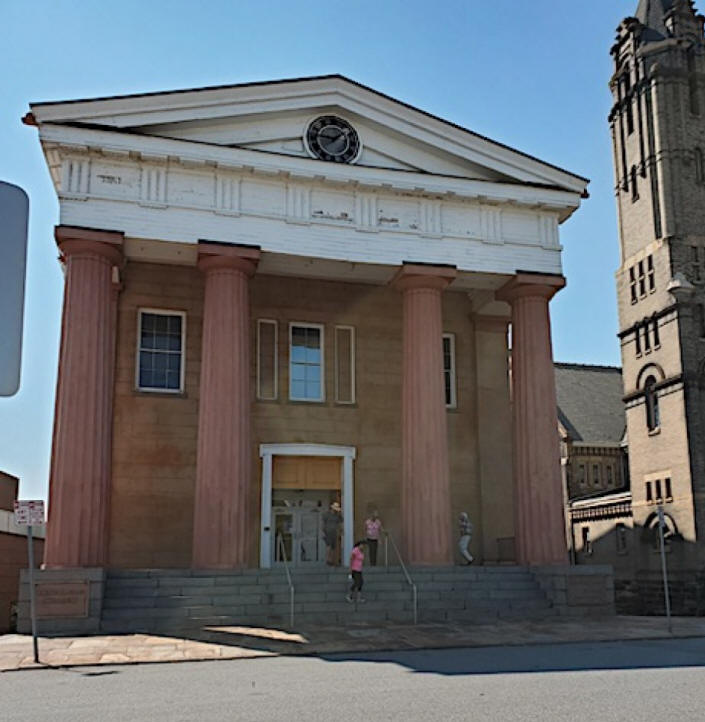
|
|
|
|
Lynchburg, situated in the Blue
Ridge Mountain’s foothills, is referred to as the “City
of Seven Hills” and because of its location
and precolonial settlement, the city has been at the
forefront of American history from its beginnings. The
people and events involved are well documented, their
paths are clearly indicated with markers and a series of
unique museums and historic sites allow you to immerse
yourself in Lynchburg’s legacy. Maps and guides are
available at the Visitors Center.
Lynchburg did not fall into
Union hands during the Civil War. Its major role was as
a supply and hospital center, with the 2nd largest
number of Confederate medical facilities.
Point of Honor Plantation is an
1815 Federal-style mansion. A tour begins on the
exterior with a banister crafted by one of the 30
slaves on the 750-acre plantation. The house has its
1815-30 appearance with original woodwork, paint colors
and era appropriate furnishings. The original owner,
George Cabell, was Patrick Henry’s doctor and there is
an outstanding medical exhibit on medicine of the
times. pointofhonor.org
In the 1840s and 50s those with infectious diseases were quarantined in the Pest House where most patients died. The 2-room, Pest House Medical Museum was the office of Dr. John Terrell who was appalled at the conditions during the Civil War and instituted standards of cleanliness and lowered the death rate from 50% to 5%. Audio stations relate historic information about Terrell’s office and the quarantine room. Displays include a surgical amputation kit and operating table. The cemetery offers a complete schedule of programs. October Candlelight Tours are particularly popular. www.gravegarden.org 
The boutique Craddock Terry
Hotel at Bluffwalk Center is an award-winning, 44
room, Historic Hotel of America inside the
1888 Craddock-Terry Shoe Corporation’s original brick
warehouse. Unique architectural features, granite walls,
arched casement windows and handmade bricks, enhance the
public and private spaces. Penny Loafer, a wire fox
terrier, serves as the official greeter and concierge.
The 1896 William King Jr Tobacco Warehouse hosts events
and is an ideal location for weddings and receptions.
.
Renee Gordon has written a weekly travel column for the Philadelphia Sun Newspaper for the past fifteen years and has published articles on local, national and international travel in numerous publications. Her columns focus on cultural, historic and heritage tourism and her areas of specialization are sites and attractions related to African American and African Diaspora history. Renee has been a guest radio commentator on various aspects of tourism and appeared in a documentary, "The Red Summer of 1919". As an educator for thirty years she was an English teacher, event and meeting planner, served as an educational consultant and intern-teacher mentor. She contributed to textbooks on women's history and classroom management and has facilitated workshops on both subjects. Renee considers herself a "missionary journalist" and as such she continues to promote heritage and sustainable tourism. 2013 Recipient of African Diaspora World Tourism Flame Keeper in Media Award for Travel Writing Affiliations
We'd love your comments!
|
Connect with us on:
American Roads and | ||||||||
|
Public Disclosure--
Please Read The FTC has a law requiring web sites to let their readers know if any of the stories are "sponsored" or compensated. We also are to let readers know if any of our links are ads. Most are not. They are just a way to direct you to more information about the article where the link is placed. We also have several ads on our pages. They are clearly marked as ads. I think readers are smart enough to know an ad when they see one but to obey the letter of the law, I am putting this statement here to make sure everyone understands. American Roads and Global Highways may contain affiliate links or ads. Further, as their bios show, most of the feature writers are professional travel writers. As such we are frequently invited on press trips, also called fam trips. On these trips most of our lodging, dining, admissions fees and often plane fare are covered by the city or firm hosting the trip. It is an opportunity to visit places we might not otherwise be able to visit. However, no one tells us what to write about those places. All opinions are 100% those of the author of that feature column. |
|||||||||
|
Privacy Policy/ Archives /
Contributors /
Subscribe to
American Roads Books by
Kathleen Walls /
Contact /
Sponsor or Advertise/ American Roads & Global Highways Home Page
|





























